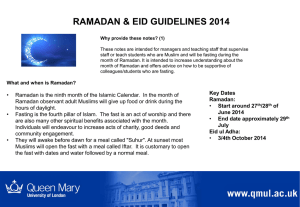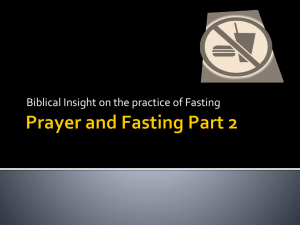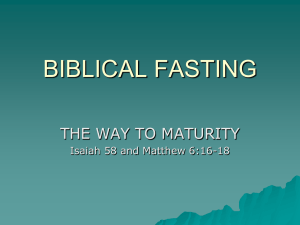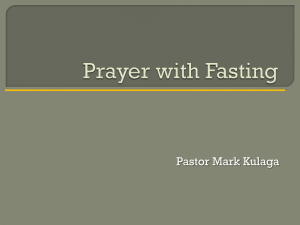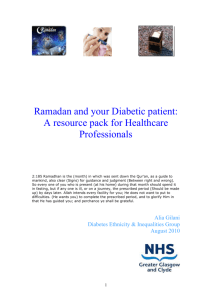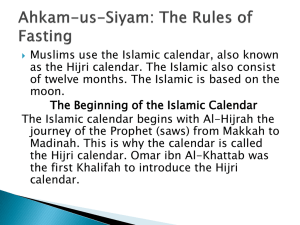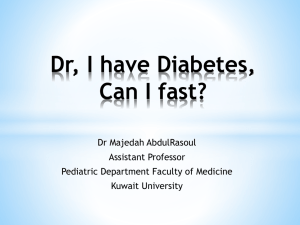- 2nd Amiri Diabetes Conference 2014
advertisement
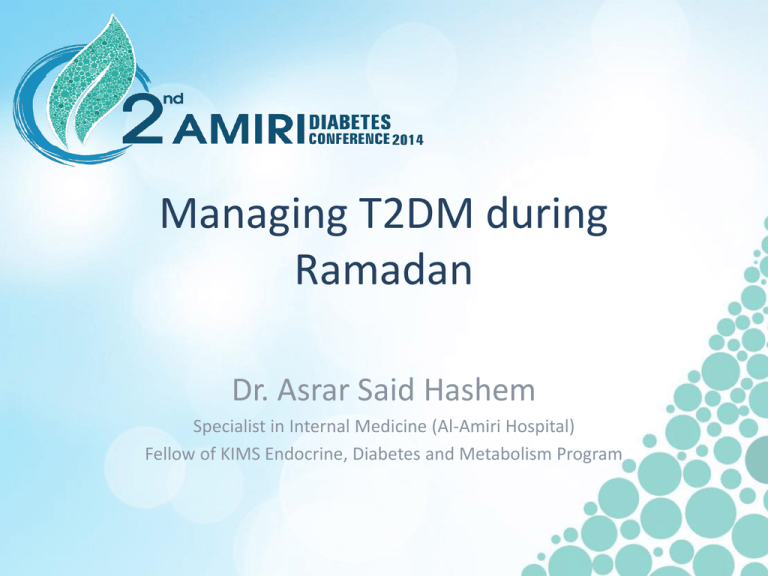
Managing T2DM during Ramadan Dr. Asrar Said Hashem Specialist in Internal Medicine (Al-Amiri Hospital) Fellow of KIMS Endocrine, Diabetes and Metabolism Program Case-1 • 59 years old gentleman • T2DM for 4 years • On – Metformin 2 gm/ day – Sitagliptin 100 mg/ day – Gliclazide MR 60 mg/ day • A1c 7.2% • To fast or not to fast? Case-1 • Pre-Ramadan Medical Assessment – Individual risk stratification – Medication changes – Ramadan-focused diabetic education Diabetes and fasting Ramadan: summary of recommendations of the organization of the Islamic Conference Category 1: very high-risk group Category 2: high-risk group severe hypoglycaemia within the last 3 months prior to Ramadan Patients with moderate hyperglycaemia blood glucose levels of 10.0–16.5 mmol/L (180–300 mg/dL) or high HbA1C (> 10%) Patients with a history of recurrent hypoglycaemia Patients with lack of hypoglycaemia awareness Patients with renal insufficiency Patients with advanced macrovascular complications Patients with sustained poor glycaemic control Ketoacidosis within the last 3 months prior to Ramadan People living alone who are treated with insulin or sulphonylureas Type 1 diabetes Patients living alone with comorbid conditions that present additional risk factors Acute illness old age with ill healt Hyperosmolar hyperglycaemic coma within the previous 3 months Drugs that may affect cognitive state Patients who perform intense physical labour Category 3: moderate risk Pregnancy Well-controlled patients treated with short-acting insulin secretagogues such as repaglinide or nateglinide Patients on chronic dialysis Category 4: low risk Well-controlled patients treated with diet alone, metformin, or a thiazolidinedione, who are otherwise healthy Hassanein M, et al. Diabetologia 2009;52:367-8 Case-1 • Low risk • Good glycemic control • Rx – Sitagliptin: no change, given at Iftar – Metformin: 1000 mg at Iftar, 500 mg at Suhur – Gliclazide MR: reduce to 30 mg at Iftar Case-1 • Ramadan-focused diabetic education – Standard diabetic education – Monitoring CBG – When to break the fast – Diet – Exercise READ Study Ramadan Education and Awareness in Diabetes Program for Muslims with T2DM who fast during Ramadan • Determine impact of Ramadan-focused education on weight and hypoglycemic episodes – T2DM taking oral glucose lowering agents • Prospective Analysis – Group A (n=57) attended 2-hr structured education program – Group B (n=54) Did not • Results – Group A • Mean wt loss of 0.7 kg • Decrease in total no. of hypoglycemic attacks (9 → 5) – Group B • Mean wt gain of 0.6 kg • Increase in total hypoglycemic attacks (9 → 36) Diabet. Med. 27, 327-331 (2010). QUESTIONS? Case-2 • 77 years old lady • T2DM for 14 years • Complicated by – Preproliferative Retinopathy – Peripheral Neuropathy – Stage 2 CKD • Hypertension • Dyslipidemia • CAD (PCI and stent to LAD in 2011) Case-2 • On – – – – – – – Insulin glargine 42 units/ day Actrapid insulin 10 – 14 – 8 units pre-meals Metformin 2 gm/ day Valsartan 160 mg/ day Atrovastatin 40 mg/ day Aspirin 81 mg/ day Isosorbide mononitrates 30 mg/ day • A1c 10.6% • To fast or not to fast? Case-2 • Pre-Ramadan Medical Assessment – Individual risk stratification – Medication changes – Ramadan-focused diabetic education Diabetes and fasting Ramadan: summary of recommendations of the organization of the Islamic Conference Category 1: very high-risk group Category 2: high-risk group severe hypoglycaemia within the last 3 months prior to Ramadan Patients with moderate hyperglycaemia blood glucose levels of 10.0–16.5 mmol/L (180–300 mg/dL) or high HbA1C (> 10%) Patients with a history of recurrent hypoglycaemia Patients with lack of hypoglycaemia awareness Patients with renal insufficiency Patients with advanced macrovascular complications Patients with sustained poor glycaemic control Ketoacidosis within the last 3 months prior to Ramadan People living alone who are treated with insulin or sulphonylureas Type 1 diabetes Patients living alone with comorbid conditions that present additional risk factors Acute illness old age with ill healt Hyperosmolar hyperglycaemic coma within the previous 3 months Drugs that may affect cognitive state Patients who perform intense physical labour Category 3: moderate risk Pregnancy Well-controlled patients treated with short-acting insulin secretagogues such as repaglinide or nateglinide Patients on chronic dialysis Category 4: low risk Well-controlled patients treated with diet alone, metformin, or a thiazolidinedione, who are otherwise healthy Hassanein M, et al. Diabetologia 2009;52:367-8 Case-2 • High risk • Poor glycemic control • Patient should be prohibited from fasting Case-2 • Patient insists on fasting! – Clearly explain the risks of fasting – Possible complications – Ramadan-focused diabetic education • • • • Standard diabetic education Monitoring CBG When to break the fast Diet Major risks associated with fasting in patients with diabetes • • • • Hypoglycemia Hyperglycemia Diabetic ketoacidosis Dehydration and thrombosis Hypoglycemia • Risk of severe hypoglycemia in EPIDIAR study • Ramadan fasting 2001 • 5-fold increase in T1DM • 7.5-fold increase in T2DM salti I, Benard e, Detournay B et al. Diabetes Care 2004; 27:2306-11. Hyperglycemia and DKA • Severe hyperglycemia requiring hospitalization • 5-fold increased in T2DM • 3-fold higher in T1DM – With or without ketoacidosis salti I, Benard e, Detournay B et al. Diabetes Care 2004; 27:2306-11. Dehydration and Thrombosis • Dehydration → Hard physical labor • ↑ risk of Thrombosis among diabetics • ↓ endogenous anticoagulants • Impaired fibrinolysis • ↑ clotting factors Case-2 • Medication Adjustments – Insulin glargine: • Dose reduction by 20% • Given at Iftar – Actrapid Insulin • Launch dose at Iftar • Reduced Dinner dose at Suhur – Metformin • 1000 mg at Iftar, 500 mg at Suhur QUESTIONS? Case-3 • 65 years old lady • T2DM for 16 years • Complicated by – Proliferative Retinopathy – Peripheral Neuropathy – Stage 3 CKD • Hypertension • Dyslipidemia • Admitted to the hospital 3 weeks ago with hyperosmolar hyperglycemic state (HHS) secondary to urosepsis Case-3 • On – – – – – Insulin glargine 46 units/ day Actrapid insulin 12 – 16 – 10 units pre- meals Lisinopril 20 mg/ day Amlodipine 10 mg/ day Atorovastatin 40 mg/ day • A1c 11.4% • To fast or not to fast? Case-3 • Pre-Ramadan Medical Assessment – Individual risk stratification – Medication changes – Ramadan-focused diabetic education Diabetes and fasting Ramadan: summary of recommendations of the organization of the Islamic Conference Category 1: very high-risk group Category 2: high-risk group severe hypoglycaemia within the last 3 months prior to Ramadan Patients with moderate hyperglycaemia blood glucose levels of 10.0–16.5 mmol/L (180–300 mg/dL) or high HbA1C (> 10%) Patients with a history of recurrent hypoglycaemia Patients with lack of hypoglycaemia awareness Patients with renal insufficiency Patients with advanced macrovascular complications Patients with sustained poor glycaemic control Ketoacidosis within the last 3 months prior to Ramadan People living alone who are treated with insulin or sulphonylureas Type 1 diabetes Patients living alone with comorbid conditions that present additional risk factors Acute illness old age with ill healt Hyperosmolar hyperglycaemic coma within the previous 3 months Drugs that may affect cognitive state Patients who perform intense physical labour Category 3: moderate risk Pregnancy Well-controlled patients treated with short-acting insulin secretagogues such as repaglinide or nateglinide Patients on chronic dialysis Category 4: low risk Well-controlled patients treated with diet alone, metformin, or a thiazolidinedione, who are otherwise healthy Hassanein M, et al. Diabetologia 2009;52:367-8 Case-3 • Very High risk • Patient should be prohibited from fasting Case-3 • Patient insists on fasting! – Strongly insist against fasting – Clearly explain the risks of fasting – Possible complications Case-3 • Patient insists on fasting !!! – Ramadan-focused diabetic education • • • • Standard diabetic education Monitoring CBG When to break the fast Diet – Medication Adjustments • Insulin glargine: – Same Dose – Given at Iftar • Actrapid Insulin – Launch dose at Iftar – Reduced Dinner dose at Suhur QUESTIONS? Key Points • Pre-Ramadan Medical Assessment (2-3 months ahead) – The passion to fast should be directed to improve diabetes-related targets and reduce the possible complications • Individual risk stratification – The risk category for many people could be higher or lower depending on many changes such as an acute illness, pregnancy, a change in type of treatment • Review of medication and plan for changes Key Points • Ramadan-focused diabetic education – – – – Monitoring CBG When to break the fast Diet Exercise • Aim for a safe fasting of your diabetic patient Thank you

